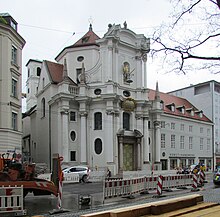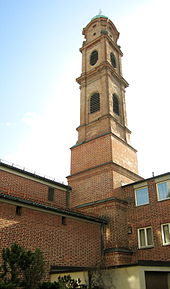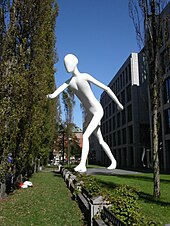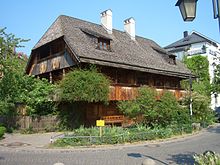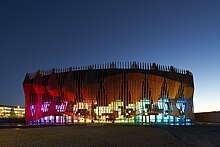Sights in Munich
The Bavarian capital of Munich has numerous urban and architectural sights . They shape the cityscape .
Old town
Marienplatz
In the center of Munich is the Marienplatz with the Marian column , the New Town Hall and its famous carillon and the Old Town Hall .
Marienplatz lies at the intersection of the two main axes, the east-west axis between Isartor and Karlstor and the south-north axis between Sendlinger Tor and the Schwabinger Tor, which was demolished in the 19th century . In the northwest of the square is the Kreuzviertel , in the southwest the Hackenviertel , in the southeast the Angerviertel and in the northeast the Graggenauviertel .
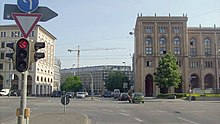
Munich's old town was almost entirely rebuilt after the destruction of the Second World War; almost all of the buildings were destroyed or damaged. Most of the buildings date largely from the post-war decades. Although large areas around the Frauenkirche were ready for rebuilding as leveled building land after the rubble had been cleared, at first glance the old town appears to be a 'grown' ensemble, the result of careful planning and monument policy, despite some radical cuts that later became the second destruction of Munich were designated.
Kreuzviertel and Stachus
To the northwest of Marienplatz is the Frauenkirche , one of the largest churches and the city's landmark. To the west, the pedestrian zone Kaufingerstraße / Neuhauser Straße leads to the Stachus with the Karlstor . The Karlstor was originally called Neuhauser Tor and, together with the Isartor and the Sendlinger Tor, was part of the second city fortification from the 14th century. Today only the two outer towers remain. In the middle part in the corners are the so-called collar heads , which represent four Munich originals. There's the coachman (Xavier) Krenkl , the English Garden King I. Ludwig overtook him and one who ko, the ko against shouted, the last Bavarian jester Prangerl , the bass player from the Hofbräuhaus Baron Sulzbeck and Finessensepperl zustellte, love letters.
In the Neuhauser Straße there are two important church buildings with the Michaelskirche and the Bürgersaalkirche . Next to St Michael, the largest Renaissance church north of the Alps, is the Alte Akademie , the former Jesuit college. The former Augustinian Church , also located on Neuhauser Straße (house number 2), has not been used as a place of worship since secularization and is now home to the German Hunting and Fishing Museum . The Oberpollinger department store from 1905 is located near Karlstor .
On the west side of the Stachus is the monumental Palace of Justice , built at the end of the 19th century by Friedrich von Thiersch in the neo-baroque style with a dome made of iron, steel and glass, which was new at the time. The New Justice Building behind , built in a Nordic Gothic style with two towers, was designed by the same architect. To the north is the Old Botanical Garden with the classicistic entrance portal from 1812 based on a design by Emanuel Joseph d'Herigoyen . Further north, at the junction between Maximiliansplatz and Lenbachplatz, near Maxburg, the Wittelsbacherbrunnen is located . The Maxtor is located at the confluence of the street on Prannerstrasse .
The Künstlerhaus , a kind of clubhouse for Munich artists, is located on Lenbachplatz . It was built by Gabriel von Seidl around 1890 and designed inside by Franz von Lenbach . Also on Lenbachplatz are the Maxturm from the Renaissance period , the last remnant of Maxburg , which was destroyed in the Second World War , the former Bavarian stock exchange built around 1890 in neo-baroque style and the Palais Bernheimer, also built in neo-baroque forms .
Here on the northwestern edge of the old town area is the Dreifaltigkeitskirche in Pacellistraße, a votive church in the purest Italian Baroque style . The people of Munich had the church built from 1711 according to plans by Giovanni Antonio Viscardi and thus hoped to be spared the Austrians during the War of the Austrian Succession . Inside, works by Cosmas Damian Asam , Joseph Ruffini , Andreas Faistenberger and Johann Baptist Straub can be admired. The baroque Carmelite Church is to the west of the promenade on Pacellistraße .
At the Promenadeplatz , where the Munich salt market was located until the beginning of the 19th century, there is a modern monument to the First Minister Maximilian Joseph Graf von Montgelas , the creator of the new Bavaria , in front of the classical palace of the same name . In the middle of the square is the monument to Elector Max Emanuel . Next to it is the traditional luxury hotel Bayerischer Hof . The Gunetzrhainerhaus (Promenadeplatz 15) has a facade with Régence stucco and has a round arch niche with the house Madonna. The house was acquired and redesigned in 1726 by court architect Johann Baptist Gunetzrhainer . The classicist administration building of the Dresdner Bank , which was built in 1907 according to plans by Max Littmann , is located at Promenadeplatz 7 . Before more banks settled there during this time, the Bavarian aristocracy was at home in the Kreuzviertel; almost all of the preserved palaces from the 18th century can be found here. Some were replaced by the palaces of the Wilhelminian era before the First World War, and this is how the Parcus House with its dominant dome was built; it is located at Promenadeplatz 12 on the site of a baroque palace. In Kardinal-Faulhaber-Strasse, an inscription on the pavement commemorates the spot where the first Prime Minister of the Free State, Kurt Eisner, was assassinated in 1919 . In Kardinal-Faulhaber-Strasse and Prannerstrasse, there are other buildings, interrupted by Wilhelminian-style buildings, which date back to the Baroque period, several aristocratic palaces such as Palais Porcia , the Younger Preysingpalais , Palais Gise and Seinsheim or the Palais Holnstein by François de Cuvilliés . The Archbishop of Munich and Freising now resides in the latter. To the north on Salvatorplatz are the Palais Minucci , the Literaturhaus and the late Gothic cemetery church of St. Salvator . Here at the former maiden tower there are other remains of the medieval city wall.
Angerviertel and Hackenviertel
The Angerviertel is located in the southeast of the old town. Just south of Marienplatz is the city's oldest parish church, the Old Peter , from whose tower you have an excellent view of the city. Adjacent is the Viktualienmarkt with the Heiliggeistkirche , a Gothic hall church that was later redesigned in the Baroque era . The Schrannenhalle was rebuilt next to the market . Further west at the Rindermarkt south of the Peterskirche is the medieval lion tower , one of the oldest buildings in the city. The richly decorated Ruffini House is nearby .
From Marienplatz to the south, Rosenstrasse and Sendlinger Strasse lead to Sendlinger Tor . The Sendlinger Tor, of which only the side towers have survived, belonged, like the Isartor and the Karlstor, to the city fortifications from the 14th century . The important Asam Church is located on Sendlinger Straße . The ORAG-Haus , St.-Jakobs-Platz with the Munich City Museum and the Ignaz-Günther-Haus , in which the sculptor Ignaz Günther had an apartment and workshop, are located on the parallel Oberanger . Until it was demolished in 1955 due to severe damage in World War II (December 1944), St. Jakob am Anger was the last remaining Romanesque church in the old town; today there is a modern church building in place of the old church. The Jewish Center was inaugurated on St.-Jakobs-Platz in November 2006 . Next is south on Roßmarkt the style of the late Rococo by François de Cuvilliés the Younger built a new countryside building , today in which the German Master School of Fashion is. To the south of the Altstadtring are the main fire station , the St. Willibrord church , the building for the Munich puppet theater and the city high-rise .
In the Hackenviertel in the south-west between Sendlinger Straße and Neuhauser Straße are the Gothic Kreuzkirche and the Baroque collegiate church of St. Anna , which was rebuilt after being almost completely destroyed during the war. The Rococo Palais Lerchenfeld is located at 8 Damenstiftstraße . The Hundskugel, allegedly the oldest inn in Munich , has been located at Hotterstraße 18 since 1440 . The Haus zur Hundskugel , on the other hand, is baroque. In the Hackenstrasse there is also the wheel player house of the gold maker Joseph Radlayers , which still has one of the few preserved typical old Munich inner courtyards. The Black House , in which the administrative headquarters of the Süddeutscher Verlag was located and which was an important example of post-war Munich architecture, stood on Färbergraben . However, the building was demolished in the course of the publishing house's relocation to the outskirts. The new Herzogspitalkirche with a restored baroque brick tower and the Palais Voronzow , a classicist building from 1808, are located in Herzogspitalstrasse . After the destruction of the Second World War, only the street name reminds of the neighboring Josephspital and its baroque hospital church. The Museum of Urban and Contemporary Art has been located at Hotterstrasse 12 since 2016 . In 2017, the memorial to the lesbians and gays persecuted during the Nazi era was inaugurated on the corner of Oberanger and Dultstraße .
Graggenau Quarter and Museum Island
From Marienplatz to the north you can either take the Theatinerstraße, which was heavily damaged in the war and was once characterized by many rococo facades, with the five courtyards and other exclusive shops, or via Residenzstraße to Odeonsplatz . The Residenzstrasse leads past Max-Joseph-Platz with the Eilleshof , the Palais Toerring-Jettenbach , the National Theater , the New Residence Theater and the royal building of the Munich Residence , and on to the older Palais Preysing , which was built in Rococo style by Joseph Effner opposite the Old Residence and finally arrives at the Feldherrnhalle on Odeonsplatz. In the south of the square, next to the Feldherrnhalle, is the baroque Theatine Church with its 71 meter high drum dome.
The ballroom building and courtyard garden of the Residenz with the state chancellery adjoining to the east also border on Odeonsplatz . The State Chancellery was completed in 1992 as the seat of the Bavarian government. The central part with dome comes from the Bavarian Army Museum, which was built in 1906 but destroyed in World War II. The court garden was laid out in the Italian style from 1613 to 1617. The temple of Diana is in the middle . The Tellus Bavarica , the bronze figure on the roof, is a copy of the original by Hubert Gerhard (1594), which is exhibited in the Theatinergang of the residence. It symbolizes the state of Bavaria. The former electoral gallery building from 1781 is located on the north side of the courtyard garden .
From Marienplatz to the east you come across the valley to the Isartor , where the Valentin-Karlstadt-Musäum is housed. Nearby are the remains of the medieval Prinzessturm and the beer and Oktoberfest museum in an old Gothic town house . Even further east you get to the Isar and over the Ludwigsbrücke to the Museum Island , on which the German Museum is located. To the north of it are the Vater-Rhein-Brunnen and the Praterinsel with the Alpine Museum .
From the valley to the north are the Platzl the world-famous Hofbräuhaus and nearby some magnificent town houses as the Orlando House and the House Blum , northeast of Marienplatz is the old courtyard and the Old Mint . The Weinstadl in Burgstrasse 5 by the Alten Hof is the oldest still preserved town house in Munich. The Moradellihaus is located in Hochbrückenstrasse . Large parts of the Graggenau quarter around the Alten Hof, including the Hofbräuhaus, the Alte Münze, the Pfistermühle , the Zerwirkgewölbe and the Platzl are listed as historical monuments. In the course of the construction of Maximilianstrasse, pointed arch arcades were built on the north side of the Alte Münze.
Maximilianstrasse
Maximiliansstrasse , a boulevard that King Maximilian II had built by Friedrich Bürklein from 1853, runs eastwards from Residenzstrasse at the National Theater . The buildings were built in the so-called Maximilian style , a mix of elements from the English Gothic and Italian Renaissance. In the street you will find luxury shops and trendy bars, the theater of the Münchner Kammerspiele , the building of the government of Upper Bavaria and the Museum of Five Continents . End point of the boulevard are the Maximiliansbrücke and already on the other side of the Isar in Maximiliansanlagen located Maximilianeum in which the Bavarian Parliament session. The Maximilianswerk is located on the banks of the Isar . A little south of the Isar and already in Lehel is the neo-Romanesque Lukaskirche with a magnificent dome, the largest Protestant church in the city. Because of its good acoustics, concerts are often held there.
Downtown
Lehel and Prinzregentenstrasse
The district has beautiful house facades. The monastery church St. Anna im Lehel by Johann Michael Fischer was the first rococo church in old Bavaria . Inside you can see works by the Asam brothers and Johann Baptist Straub . The square, however, is dominated by the neo-Romanesque parish church of the same name. In the north, the Lehel is bounded by Prinzregentenstrasse. The street was built from 1891 to 1912 and is named after Prince Regent Luitpold . To the north is the English Garden , with the Chinese Tower , the Monopteros, the Rumford House and the Japanese Tea House. The Haus der Kunst , the Schackgalerie and the Bavarian National Museum are located on the street . The road leads west over the Isar to the Angel of Peace , a 23 m high Corinthian column with a golden angel on it, which is supposed to commemorate the peace treaty in Versailles in 1871. The street continues past the Villa Stuck to the Prinzregententheater (see Bogenhausen). On the Isar promenade des Lehels, Widenmayerstraße , much of the original structure has been preserved.
Maxvorstadt: Brienner Strasse and Ludwigstrasse
In Arnulfstrasse on the border with Ludwigsvorstadt there are still several buildings of the once huge complex of the Ministry of Transport , which was lost in the Second World War . The listed building of the former Postpalast is located at Arnulfstraße 62 . The parcel post hall is located further west on No. 195 and in Neuhausen .
Brienner Strasse begins on Ludwigstrasse south of Odeonsplatz and runs through Maxvorstadt in a westerly direction. The Brienner Straße is divided first by Wittelsbacherplatz , then by Karolinenplatz and finally Königsplatz , until it flows into Stiglmaierplatz with the Löwenbräukeller . Its extension in Neuhausen is then called “Nymphenburger Straße”.
The Maxvorstadt is characterized by the two universities Ludwig Maximilians University and Technical University of Munich . But the Museum Quarter with the Pinakothek ( Alte Pinakothek , Neue Pinakothek , Pinakothek der Moderne ), the rededicated Türkentor , the Lenbachhaus , the Antikensammlung and the Glyptothek are also located here. In the center is the monumental Königsplatz with the Propylaea . In Richard-Wagner-Straße there are still numerous historicist houses and the building for the Bavarian State Collection for Paleontology and Geology .
South of the Staatliche Antikensammlungen lies the torso of the early Christian basilica of St. Boniface, which was badly damaged in the Second World War . From Odeonsplatz, Ludwigsstraße leads to Schwabing . In the east, Maxvorstadt and Schwabing are bordered by the English Garden . The parish church of St. Benno , built in the west of Maxvorstadt 1888–1895 according to plans by Leonhard Romeis , is next to St. Joseph the second Catholic parish church of Maxvorstadt with a parish in Neuhausen.
King Ludwig I had the monumental boulevard Ludwigsstrasse built in the classicist style according to plans by Leo von Klenze . The road is bordered by the Feldherrnhalle in the south and by the Siegestor in the north . In the southern section, buildings in the Italian Neo-Renaissance style dominate, such as the Odeon , the Leuchtenberg Palace and the former War Ministry , which today houses the main state archive. The northern part was realized by Friedrich von Gärtner when Klenze had just fallen out of favor. Gardeners longer feels the forms of the Italian Romanesque committed, of which in particular the Bavarian State Library , the Ludwig Maximilians University and the Ludwig church witness. The university church was built from 1829 to 1844. Inside are frescoes by Peter von Cornelius . To the west of the Siegestor lies the magnificent three-wing complex of the art academy . To the east on Kaulbachstraße are the artist's villa of the same name and the Palais Seyssel d'Aix .
Schwabing
The extension of Ludwigstrasse to the north is Leopoldstrasse , which is dominated by more modern buildings. There are still some stately houses at the Siegestor (Leopoldstrasse 4,6,8, 20). Leopoldstrasse is the central nightlife and promenade, here soccer games are celebrated by the respective fans. The cafes on the roadside thrive on the need to see and be seen.
The parish church of St. Ursula is located in the first Wilhelminian expansion area west of Leopoldstrasse and south of Münchner Freiheit and was created when the old parish church of St. Sylvester proved too small at the end of the 19th century.
East of Münchner Freiheit, which was called Feilitzschplatz until the Second World War, is around Occamstraße Altschwabing . The Walking Man stands out on Leopoldstrasse , a huge figure in front of the Munich Re building , which was designed in 1995 by the Californian artist Jonathan Borofsky . The main building of Munich Re further east on Koeniginstrasse is a splendid historicist building. The Seidlvilla is on Nikolaiplatz . The Suresnes Castle is located on the Werneckstraße.
From 1890 to the First World War, Schwabing was a famous artists' quarter and home and workplace of numerous painters and writers. Some art nouveau villas still bear witness to this time. For example, the Pacelli-Palais (Georgenstrasse 8) by Josef Hölzle from 1881, the Palais Bissing (Georgenstrasse 10) by Ernst Robert Fiechter , the Romeis houses (Schackstrasse 1,2,4), the houses Ainmillerstrasse 22 and Römerstrasse 11 by Henry Helbig and Ernst Haiger and the building Belgradstrasse 22/24 by Johann Lang . Further Art Nouveau buildings can be found in Kaiserstraße, Isabellastraße and Franz-Joseph-Straße. The Schwabing riots broke out here in the 1960s . Today Schwabing is still a popular nightlife district with numerous cinemas and pubs. The scene is mixed and is shaped by both students and a chic Micki scene.
North of Münchner Freiheit with the Church of the Redeemer , Leopoldstrasse is becoming increasingly unattractive. It is transformed into a pure entry and exit lane, which is lined left and right by more functional residential, office and hotel complexes. After crossing the Middle Ring, it is worth making a detour east to the newly emerging Parkstadt Schwabing with the 126 and 113 meter high Highlight Towers , two new high- rise buildings by Helmut Jahn , about which there was a heated argument before construction began. In the meantime, they have been implemented, although a referendum on this topic meant that the magical limit of 99 m (height of the taller of the two towers of the Frauenkirche in the center of the city) must not be exceeded in all future high-rise buildings. The Nordfriedhof is located on Ungererstraße , the funeral hall of which is described in Thomas Mann's novella Death in Venice. The interior of the Greek Orthodox Church of All Saints at the cemetery shows a combination of gold, light and color.
The former royal armory is located in the west of Schwabing on Lothstrasse . The old riding arena is also located in the west of Schwabing. The location for the neo-baroque Prinz-Leopold-Kaserne is part of the military area on the Oberwiesenfeld , which adjoined today's Heßstrasse. The Nordbad comes from the time of National Socialism . The Bamberg house is in Luitpoldpark .
Isarvorstadt (Glockenbach- and Gärtnerplatzviertel)
The center of the Gärtnerplatzviertel south of the old town with its numerous pubs is the Gärtnerplatz square with the Gärtnerplatztheater . The theater was built in 1864 by wealthy families in the district. Today it is in state hands. The skyscrapers of the European Patent Office and the German Patent Office stand on the Isar .
In the 1990s, the Glockenbachviertel developed from a simple-people-quarter into a trendy quarter. The gay and lesbian scene has settled around Müllerstrasse. Numerous pubs and artist studios were also found. The Luitpold-Gymnasium also stood in Müllerstrasse , the construction of which went back to the first building for the royal garrison hospital by Karl Albert von Lespilliez (1777). Today the skyscraper The Seven, which emerged from a thermal power station, is located here . The Romanizing church of St. Maximilian stands on the Isar . St. Anton is another neo-Romanesque sacred building in the south of the Isarvorstadt . The baroque dome of the painful chapel was integrated into the building right next door .
While most of Munich's city streams in the district are now drained or run underground, part of the Westermühlbach still flows openly in the west. Adjacent is the Alte Südfriedhof , where numerous prominent Munich residents are buried. At its northern end is the early baroque church of St. Stephen .
Ludwigsvorstadt, Schwanthalerhöhe (Westend) and Theresienwiese


The Ludwigsvorstadt near the main train station has a strong international character. The Bayerpost , which has been converted into a hotel, has been preserved on the south side . Schillerstraße is particularly famous for the alternating electronic and computer shops, sex shops and doner kebab shops . The Royal Anatomy , one of the first large reinforced concrete structures in Germany, is located on Pettenkoferstrasse . The district is also home to the Deutsches Theater , and in 2003, Mathäser, a large cinema with modern architecture, opened on Bayerstrasse . The rococo church of St. Elisabeth, begun in 1758, is located on Mathildenstrasse, with a facade from 1790, the interior of which is marked by the destruction of the Second World War. The Frauengebäranstalt, the first building in the Maximilian style by the architect Friedrich Bürklein, was built in 1856 on Sonnenstrasse . Here, further north in the middle of the street, the first building of Munich's evangelical bishop's church, St. Matthäus , once stood , the new building is now south of the Nussbaumpark .
Further to the southwest, the world-famous Oktoberfest takes place every year on the Theresienwiese directly below the Bavaria and the Hall of Fame . The church of St. Paul and the former shower bath are located on the northeastern edge of the spacious area . After the trade fair was moved to the east of the city, the former exhibition center on the western edge of the Bavariapark now houses the traffic center of the Deutsches Museum . The old congress hall is nearby . St. Benedikt is located on Schrenkstrasse in the Schwanthalerhöhe district (" Westend "). Together with the churches of the Visitation of Mary in Ridlerstraße and St. Rupert on Kiliansplatz, it belongs to the Munich-Westend parish association. In the north of the district on the main S-Bahn line is the monumental main customs office from the time of the Prince Regents , which, like the buildings for the Army Museum and the Ministry of Transport, was intended to emphasize the Bavarian independence in the empire. The "Endless Staircase" by "Umschreibung", an installation by the Danish artist Olafur Eliasson, is located at Ganghoferstrasse 29.
Bogenhausen
In the Bogenhausen district to the right of the Isar, northeast of the old town, stands the rococo chapel of St. Georg on the Bogenhausen church square , built by Johann Michael Fischer from 1766 to 1768. Also worth seeing is the Hildebrandhaus, which houses the Monacensia , a Munich manuscript collection and library.
The Arabellapark office district is characterized by the 114-meter-high Hypo-Haus and high-rise hotel buildings. The 52-meter-high sculpture Mae West is on Effnerplatz .
Villa Stuck is located on Prinzregentenstrasse , designed by Franz von Stuck in 1897/1898 in the style of classicism and art nouveau . Today, in addition to changing exhibitions and the living rooms of the painter prince, exhibits from Munich Art Nouveau can be seen here. The Prinzregententheater is located on Prinzregentenplatz . The theater was built in 1900/1901 by Max Littmann in a mix of neoclassicism and art nouveau. The Monacensia is located in the Hildebrandhaus . Nearby on Höchlstrasse is the Art Nouveau villa by Rudolf Diesel, also built by Max Littmann opposite his own villa . The palatial neo-baroque butcher's palace was acquired by the Reichsfinanzhof, today the Federal Fiscal Court is located here . The Villa Bechtolsheim is located at Maria-Theresia-Straße 27, right near the Hildebrandhaus, the oldest preserved Art Nouveau building in Germany, built by Martin Dülfer for Baron Clemens von Bechtolsheim. The classicist Höchl-Schlössl served at times as an artist's villa.
Haidhausen, Au and Giesing
These districts to the east and south-east of the old town on the right bank of the Isar were not incorporated into Munich until 1854 and were long considered living quarters for workers and day laborers. Only a few of the low so-called hostel houses have survived today, such as the Üblacker-Häusl at Preysingstrasse 58, which is now a hostel museum. The Kriechbaumhof directly opposite is also striking . From 1879 to 1900 the so-called French Quarter was built in Haidhausen , which was planned by Arnold Zenetti as a modern tenement district. In the 1970s, the old buildings in Haidhausen were extensively renovated and the quarter became a trendy district. The old parish church of St. Johann Baptist has been preserved. The nearby new St. Johann Baptist Church in Haidhausen is one of three large neo-Gothic churches in this district on the right bank of the Isar and the largest of them. The neighboring church of St. John , on the other hand, has neo-Romanesque architecture. In the church road is as a grand assembly, the former Brausebad of Carl Hochneder .
On the Isar is the Müllersche Volksbad , a large Art Nouveau bath , also built by Hocheder. Not far from there is the Muffatwerk and the Gasteig cultural center , which is also the house of the Munich Philharmonic and the main building of the Munich adult education center , the Munich city library and a branch of the Munich University of Music and Theater . The late Gothic church of St. Nikolai am Gasteig with the attached Loreto chapel is also located on the Gasteig . Further to the southeast is St. Wolfgang with its neo-baroque tower.
The center of the Au is the Mariahilfsplatz with the neo-Gothic Mariahilfskirche , the oldest of the three large neo-Gothic churches to the right of the Isar. The Auer Dult also takes place on the square . At Mariahilfplatz 17 in the former district court, the Munich District Office is located in a stately, neo-baroque group building with a tower . The Nockherberg is also located in this quarter.
In Obergiesing there is the east cemetery with a monumental domed building as well as the neo-baroque welfare house St. Martin , in Untergiesing the Birkenleiten castle .
With the beginning of the post-war period, the Giesing district saw the rebuilding of war-torn houses and the development of building land reserves, and around 3/4 of the housing stock was built after 1948. Only in Alt-Giesing , primarily around the neo-Gothic hall church Heilig Kreuz , built in 1886 on the Isar slope edge, have individual historical suburban ensembles been preserved. The Holy Cross Church is also the only one of the large neo-Gothic churches to the right of the Isar that has been preserved in its original form. In Untergiesing there is also the neo-baroque church of St. Franziskus .
Neuhausen, Gern and Nymphenburg
In the district of Neuhausen, northwest of the old town, the largest beer garden in the city, the Gothic Winthirkirche and the futuristic Herz-Jesu-Kirche are located in the Hirschgarten . The Neuhausen settlement was established in 1928 . The neo-Gothic Christ Church and the Heiliggeistspital, a spacious, monastery-like neo- baroque complex, are located on Dom-Pedro-Platz . St. Theresia is close by on Landshuter Allee , which crosses the Nymphenburg-Biederstein Canal .
Gladly is characterized by numerous villas and the palace canal to the adjacent Nymphenburg Palace with its palace gardens . Right next to the castle is the botanical garden and the Museum of Man and Nature . Many small properties, some with half-timbered gables and studio windows as well as gardens in front and back, were built in the Nymphenburg district, mostly close together in the style of English brick row houses. The Hubertus Fountain is located at the east end of the Nymphenburg Canal .
Sendling
The old village of Sendling south of the old town was the scene of the Sendling Murder Christmas in 1705 . Around the old parish church of St. Margaret the old village center is still clearly recognizable. The Stemmerhof was one of the last farms in the inner city area. The large parish church of the same name near the Harras was built at the beginning of the twentieth century (1905) in Italian neo-baroque, to commemorate the elevation of Bavaria to kingdom a hundred years earlier, but also to commemorate the Sendlinger Murder Christmas, which was two hundred years ago. With St. Korbinian and St. Achaz Sendling has two other neo-baroque churches. The Munich wholesale market hall is located in the immediate vicinity of St. Korbinian . The Harras is an important traffic junction in the district. On the north side of the triangular area, there are several Art Nouveau houses from around 1900, the south side is bordered by a post office, which is one of the classics of modern architecture in Munich. The construction of a mosque at Gotzingerplatz further south failed . The impressive building of the St. Josef retirement home on Luise-Kiesselbach-Platz with its magnificent bell towers was built until 1928 and is today a landmark of Sendling with its neo-baroque church.
Outskirts
Munich south
Isar floodplains, Thalkirchen and Harlaching
The Isar floodplains through the city have been extensively renatured in the southern section. The river, which was previously forced into a canalised corset, can now flow freely again. The gravel banks of the Flaucher are heavily frequented by bathers and barbecue parties in summer.
Opposite the Flaucher is the Hellabrunn zoo in the south of the city . A popular bike path leads along the Isar. The section from Munich to Schäftlarn Abbey and on to Wolfratshausen is particularly attractive.
In the south of the city there are wealthy districts such as Harlaching or Grünwald, which is no longer part of Munich . The old pilgrimage church of St. Anna and the Menterschwaige manor are located on the Isar high bank in Harlaching . In Grünwald there is also the Bavaria Filmstadt and the only medieval castle that has survived in the Munich area, Burg Grünwald with exhibitions from the State Archaeological Collection .
The Asam-Schlössl is the former home of the baroque artist Cosmas Damian Asam in the Thalkirchen district of Munich . The church of St. Maria Thalkirchen dates from the baroque period. Isarwerk 1 is located on the Isar .
Fürstenried, Forstenried and Solln
In Fürstenried is that of Joseph Effner built Schloss Fürstenried until 1916 in the 1883 insane applicable King Otto of Bavaria lived. The church of Forstenried is known for a rare Romanesque cross that is inside. The Derzbachhof in Forstenrieder Allee 179 in the center of Forstenried from 1751 is considered the oldest farm in the city, the property is also known in the district under the name Feichtbauernhof. South of Munich, the large forests of Perlacher Forst and Fürstenrieder Forst spread out, which are heavily frequented by walkers and cyclists.
The old village center of Solln is listed as an ensemble. There is the one from the 15./17. The old Sollner church dating back to the 19th century , the Sollner Hof inn built in 1892 and other heritage-protected farmhouses and houses. The core of the Gut Warnberg manor house dates from 1667. Like the villa colony Prinz-Ludwigs-Höhe on the Isar high bank towards Thalkirchen, the villa colony Solln is characterized by numerous listed villas from the end of the 19th and beginning of the 20th century.
Munich west
Pasing
In the west is Pasing , which was elevated to a town in 1905, but was then incorporated into Munich in 1938. The center is the Pasing Marienplatz with the Marian column. The Pasing town hall and the Pasing Viktualienmarkt as well as the parish churches of the Birth of Mary and the Protection of Mary are nearby . The New Baroque Church of the Assumption is located near the old Pasing train station .
From the Pasing moated castle, a castle-like fortification surrounded by the Würm, only the castle island, some medieval vaults and the moat have survived. The Pasinger factory at the train station today is a cultural center. The district is traversed by the Würm , here is also the Pasing city park . The late Classicist Gatterburg Palace is also located in Pasing .
Pipping, Aubing, Lochhausen and Freiham
Blutenburg Castle with the well-known late Gothic castle chapel is located north of Pasing an der Würm . The St. Wolfgang Church in Pipping has also been preserved with its original late Gothic furnishings .
The Romanesque tower of the Catholic Church of St. Quirin is the oldest preserved building in Aubing further west of Pasing. The Aubing water tower is also a landmark of Aubing . Near Neuaubing you will find the medieval Gut Freiham with its Holy Cross Church and Freiham Castle, which gave the new Freiham district its name . St. Michael in Lochhausen dates from the Gothic period.
Großhadern, Laim and Westpark
Even St. Peter in Grosshadern is one of the churches from the Gothic period. In Großhadern there is also the forest cemetery , the largest cemetery in the city.
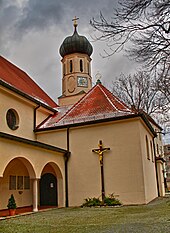
Between the Westend and Pasing, in the Laim district, there is the rural-looking Catholic parish church of St. Ulrich with the traditional onion dome , surrounded by a village-like cemetery, in which no burials have been carried out since the beginning of the 20th century. The Laimer Schlössl in Agnes-Bernauer-Straße was built under Max Emanuel as a farm building in the no longer existing Laimer Schlossgut, and later rebuilt.
In the West Park , which hosted the International Horticultural Exhibition in 1983 , is the East Asian ensemble with a Nepalese pagoda, a Thaisala and the Chinese and Japanese gardens.
Munich north
Freimann and Fröttmaning
In the north of the city there are also some districts that grew strongly or even emerged in the 1960s and 1970s. St. Nikolaus in Freimann dates from the 14th century. The largest student housing estate in Germany, the student town of Freimann, is also located in Freimann .
The new football stadium, the Allianz Arena, is located in Fröttmaning . Right on the other side of the motorway is the oldest church that has been preserved within the present city limits, the Holy Cross with a Romanesque fresco. In addition to the arena, the north art park is planned as the successor to the east art park . South of the arena is the Showpalast Munich with its wooden grid shell (Graft Architects), built as a permanent theater for the Apassionata horse show.
Garching with its university buildings and Oberschleißheim with the Flugwerft and Schleißheim Palace are just beyond the northern city limits .
Feldmoching, Milbertshofen and Olympiapark
Feldmoching still looks almost rural. It was once the main town in what is now the north of Munich with its own church (around 700) and official residence. With the founding of Munich and later the construction of Schleissheim Palace (1599), Feldmoching lost its importance. The church of St. Peter and Paul, however, still has a medieval core, the rectory originally dates from the 18th century.
The old St. George's Church in Milbertshofen is only partially preserved . Also in the Milbertshofen-Am Hart district is the Olympic Park with the Olympic Tower , the Olympic Stadium and the Olympic swimming pool . To the north of this is the Olympic Village and neighboring the BMW high-rise , BMW Group Classic and BMW Welt . The East-West Church of Peace, which was once built as a black building, is located in the park .
Moosach, Allach and Menzing
Further west on Georg-Brauchle-Ring in Moosach is the city's highest high-rise building at 146 meters, Uptown Munich . In Moosach there is also the Olympia shopping center , the Westfriedhof with its funeral hall, a large domed building, as well as the late Romanesque old parish church of St. Martin and the Pelkovenschlössl . In Allach the Gothic church are St. Peter and Paul and the modern castle Allach . The late Gothic parish church of Untermenzing is also called St. Martin . In Obermenzing , the Apfelallee is part of a Wilhelminian-style villa colony .
Munich east
Ramersdorf, Perlach and Berg am Laim
In Ramersdorf with its Gothic-Baroque pilgrimage church of the Assumption of Mary and in Perlach with the baroque parish church of St. Michael , the structure of the old village centers is still clearly recognizable. One of the oldest buildings in Perlach is the so-called Schloss Perlachsoed . In contrast, St. Paulus is one of the oldest neo-Gothic churches in Bavaria.
The transverse skyscraper of the Medienbrücke was built near the Ostbahnhof by 2012 . Not far from there are the TenTowers , the New Technical Town Hall and the SV high-rise, three other high -rise complexes in the east of the city.
In Berg am Laim (Clemens-August-Str. 9) there is St. Michael, an important church of the Bavarian Rococo . It was built from 1738 to 1758 by Johann Michael Fischer. Inside works by Johann Baptist Zimmermann , Johann Baptist Straub and Ignaz Günther . St. Stephan nearby in Baumkirchen was built in the late Gothic period.
Johanneskirchen, Englschalking, Daglfing and Oberföhring
In the east of the Bogenhausen district , in addition to Altbogenhausen in the city center, further outside in the east of the city there are numerous old settlements, some of which have survived the village centers and some of them entirely.
The late Romanesque choir tower church of St. Johann Baptist can be found in Johanneskirchen . With St. Nikolaus , Englschalking also has a former village church from the Romanesque period. St. Philipp and Jakob in Daglfing , on the other hand, was rebuilt in the Baroque period.
The baroque church of St. Lorenz and the Goetz Collection are located in Oberföhring , and the St. Emmeramsmühle in St. Emmeram .
Other old village centers, of which little has survived, are in Zamdorf , which towers above the modern SV high-rise , and in Denning . In contrast, the Steinhausen district with the high-rise buildings on Vogelweideplatz is very modern .
Riem and Trudering
A new city district was created on the site of the former Munich-Riem Airport , with the Riemer Park as a landscape park for the Federal Horticultural Show 2005 and the new exhibition grounds of the Messestadt Riem with the exhibition tower . From the old Munich-Riem airport, only the listed tower building and the coat of arms hall, the former terminal building, have survived.
St. Florian in the Riemer Messestadt forms an ecumenical center and an interesting architectural ensemble with the adjacent Sophienkirche. In the two old village churches of St. Martin in Riem and St. Peter and Paul in Trudering, only a few parts still come from the original buildings.
See also
- Green areas in Munich
- Church building in Munich
- Castles and palaces in Munich
- Palais in Munich
- Museums in Munich
- Theater in Munich
- Fountain in Munich
- Monuments in Munich
- Works of art in public space in Munich
- The emergence of the Munich cityscape
Web links
- Munich city panoramas - interactive 360 ° panoramas with virtual tours



